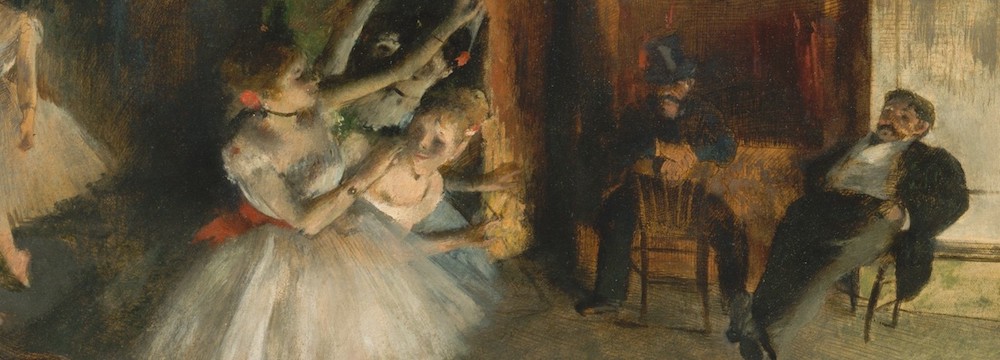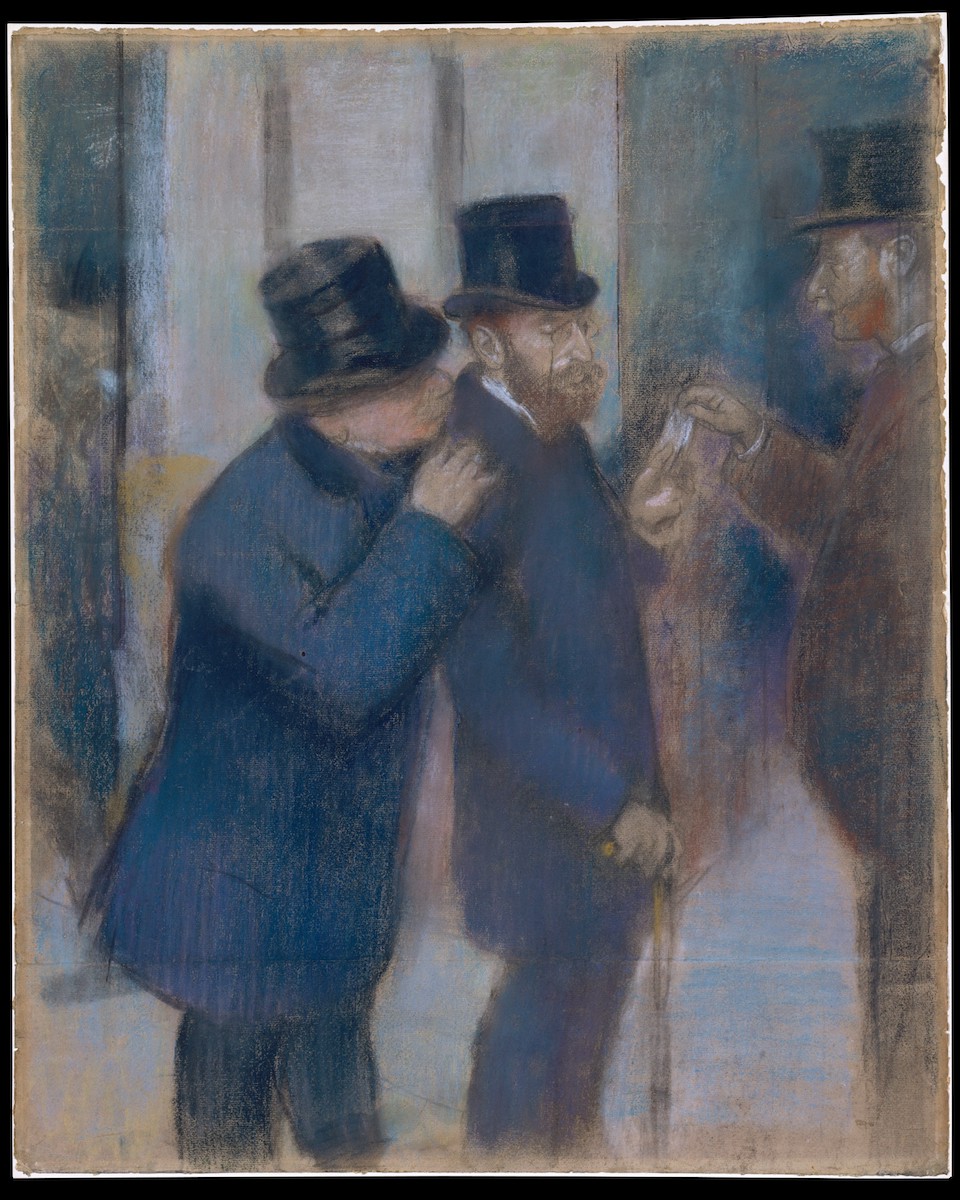Abonnés and Ballet Dancers in Room 816
 fig.1: A cropped version of The Rehearsal of the Ballet on Stage (ca. 1874) by Edgar Degas depicting two abonnés.
fig.1: A cropped version of The Rehearsal of the Ballet on Stage (ca. 1874) by Edgar Degas depicting two abonnés.
“Two male capitalist-abonnés sit casually in a room filled with young ballerina dancers: One abonné points at a ballerina and asks the other abonné …”
At first, one would consider this excerpt to be a beginning of a prejudicial anecdote, but in reality, it potentially hides a concealed message that resides within the gallery walls of Room 816 located in the Metropolitan Museum. The depiction of two “sugar-daddy” abonnés sitting in a room filled with rehearsing ballerina dancers—whom they impatiently seek to provide company afterwards—is precisely the setting depicted in The Rehearsal of the Ballet on Stage (fig.2). However, the relation that this Degas painting has to another dozen Degas paintings located in Room 816, is one that potentially conceals the more profound context for this anecdote.
 fig.2: Edgar Degas, The Rehearsal of the Ballet on Stage (ca. 1874) .
fig.2: Edgar Degas, The Rehearsal of the Ballet on Stage (ca. 1874) .
Before commencing the exposition of the room’s hidden message, it is first worth noting the subtle uniqueness of its interior setting. If one were to enter Gallery Room 816, one would not fail to notice a setting unlike in any other gallery room within the museum: the lights are very dim, the small size of the space might make it the closest to an interior at the MET that might trigger claustrophobia, and the bright orange lights that typically irradiate the gallery spaces of the museum, are substituted by a stark light that infuses the interior of the room with a dull grey tone. In other words, the character and setting of this room is unlike any other room in the museum; perhaps, it imitates the Parisian salons in which these Degas paintings were first shown to the public. In this room, one will find oneself surrounded by impressionist paintings of Edgar Degas that mostly depict young ballet dancers, amongst which hangs The Rehearsal of the Ballet on Stage (fig.2).
Out of these dozen or so paintings in the gallery room, one could notice that most paintings have ballet dancers as a common subject-matter; if some paintings don’t share this common subject-matter, then at least they have a more general theme in common—dancing. But there is one stark exception to all these paintings to which neither the subject-matter of ballet dancers nor dancing can be attributed: this exception is the Portraits at the Stock Exchange (fig.3) that depicts a crowd of capitalists in the background, presumably not far from the stock exchange, with two of the subjects in the foreground: a financier and a collector, with one of them whispering something into the ear of the other.
 fig.3: Edgar Degas, Portraits at the Stock Exchange (ca. 1878-79).
fig.3: Edgar Degas, Portraits at the Stock Exchange (ca. 1878-79).
One might be very surprised by the presence of Portraits at the Stock Exchange, but is its positioning—among paintings of dancers to which it hardly relates—an outcome of MET’s careful consideration, or a product of its incompetent institutional curation? At first, it might appear to be the latter case, but there is an urge to make a case for the former. Whether the curation of the Room 816 was made intentional or unintentional by the MET; the room hides a hidden sense of irony (maybe even a sense of genius) that begs to be expounded and revealed. This painting of the stock exchange appears to almost deliberately disharmonize the theme of the room; perhaps this is an attempt to bring to the surface the remnant critique of social norms at the time, which under this institutional setting, are better revealed. This may be a reason for why an impression of capitalists is not entirely out of place among Degas’s other paintings that hang in Gallery Room 816; particularly in relation to the formerly mentioned male abonnés depicted behind a group of ballet dancers in The Rehearsal of the Ballet on Stage (fig.2). Perhaps what connects these two paintings as two autonomous entities, is their own ontology, a language of negativity that they both clearly understand and communicate through; but it is only superficially understood by us, viewers, whose ontology of positivity only sometimes brings our understanding beyond the superficiality of the image of these paintings.
If there is indeed a hidden language of negativity that is being communicated amongst Degas paintings in Room 816, how can it be revealed to our faculty of perception and understanding? If the beholder were to consider the subject-matter of the rehearsing ballerina dancers depicted in The Rehearsal of the Ballet on Stage (fig.2), one might consider it as work of art that embodies disinterestedness—a painting intentionally produced, yet remains purposive without a purpose. However, when one considers the male abonnés in the background who find interestedness in the subjects of their desire, the status of the painting as an artwork embodying disinterestedness in a depicted world of romantic disinterested beauty—starts to short circuit. All of a sudden, the painting can longer be viewed romantically when a detail within it causes the whole composition to short circuit, producing a juxtaposition that attempts to negate the harmony and beauty of the painting. This short circuit is precisely what marks impressionist paintings in their capacity to provide meaningful pleasing depictions of everyday life, yet also include the less pleasing, hidden negative substratum beneath an image. This hidden substratum of an impressionist painting is analogous to a photographic negative film in which negativity translates into a positive, yet, an impressionist painting covertly leaves certain areas of the positive image undeveloped from its negative. These undeveloped negative areas then function as small doors into which an attentive beholder can enter and reveal the latent negativity beneath the positivity of the painting. This realm of negativity embodies a substratum of discontent subjectivity along with its contradictory material conditions and immanent inconsistencies/antagonisms within the social order—a negativity out of which the positivity of an impressionist image is constituted out of. The realm of negativity is precisely the language through which the paintings in Room 816 seem to communicate; the many short circuits within the images of these paintings is what opens the door for the viewer to this realm of negativity and critique.
If Portraits at the Stock Exchange (fig.3) and The Rehearsal of the Ballet on Stage (fig.2) are both to be considered as two paintings that convey a common social antagonism, what can this antagonism be? Here, it does not appear entirely arbitrary that Degas chose to depict a theme that underlies the conditions in which his other depictions of ballerina dancers were painted: could the depiction of the stock market be an expression of the contradictory circumstances in which the spontaneity of performance arts had become subjected to the hegemony of the bourgeois consciousness? To what extents can this social antagonism relate to the male abonnés—who while paying a fee to sit back in front of ballerina dancers—imply that performance arts had become incorporated into the market exchange in which objects of desire can be readily exchanged and purchased? Does not this seem to be a critique—which appears to be way ahead of its time—that envisioned a imminent crisis of art as it encounters the hegemony of a market economy?
It appears that these moments do indeed echo in Degas’s expressionist paintings, and once gathered together in Gallery Room 816, this negativity resonates with a profound reverb as the viewer absorbs these works in their multiplicity. In this reverb of negativity, as the viewer absorbs the content of Portraits at the Stock Exchange (fig.3) and examines the financier who whispers into the ear of the collector, they start hearing a subtle voice—could it be the financiers whisper?—they ask—Could they have gone mad and started to hear voices?—Could it be the gallery room causing claustrophobia? As the viewer becomes more attentive to the voice, the viewer starts to hear the financier whisper an anecdote to the collector:
“Two male abonnés sit casually in a room filled with young ballerina dancers: One abonné points at a ballerina and asks the other abonné …”
What the viewer might’ve heard, is the language of negativity that resonates in the voices of paintings located in Room 816.